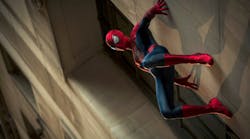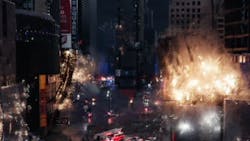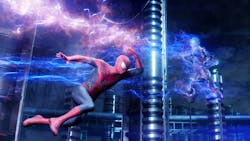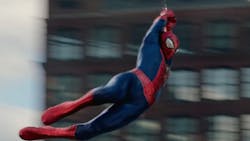The Amazing Spider-Man 2 is out now and I had a chance to talk with David Schaub, Sony Pictures Imageworks Animation Supervisor, to find out what new challenges were addressed in the latest movie. I had talked with Jerome Chen, VFX Supervisor Sony Pictures Imageworks, about first The Amazing Spider-Man (see “Spider-Man Swings Through A Virtual 3D World”) so I had an idea of what was involved in terms of animation and simulation. I also had a chance to see the film before it was released opening up a host of technical questions that David was able to answer. Also, no spoilers here since I'll be talking about just the technical aspects of the film making process.
Figure 1. The Amazing Spiderman 2 will be swinging into a theater near you.
Related Articles
- Spider-Man Swings Through A Virtual 3D World
- Pompeii, History And A Dream
- Skyfall - James Bond At Fifty Is Better Than Ever
- Prometheus Takes Flight With Cutting-Edge VFX Technology
First of all, there is plenty of swinging in this version and it is definitely one where 3D adds significantly to the enjoyment of the film. Flying through the air seemed very natural and for good reasons as the animation and simulations were grounded in physics. Of course the director and animators had plenty of leeway on how things show up on the film since this is a comic book character come to life.
There are more swinging scenes than in the first film and Spider-Man is more confident about it this time around. Recovery at the last minute by shooting a web and swinging seem very natural. I also noticed the framing this time around as Spider-Man will remain centered in the shot for the most part. This actually reduces vertigo when viewing the action scenes in 3D. It provides the viewer with an almost fixed frame of reference while the rest of the world goes flying by.
The Amazing SpiderMan 2 Animation by David Schaub On EngineeringTV.com
A good deal of the city was modeled in significant detail for the first film. This was primarily where Spider-Man would be swinging or shots related to it. A lot of it was designed for night time scenes. This time there is a lot more action in daylight as well as more area to cover. Imageworks built on their original database of objects.
This time around things like the destruction pipeline tools were more complex just like the latest games for the Sony PS4 or Microsoft XBox One. More elements were allowable so there is plenty of flying debris and broken glass. Check out the battle scenes between Electro and Spider-Man in Times Square and power plant. This movie is definitely one for slo-mo at home.
Figure 2. Spiderman and Electro have a little tiff in Times Square.
Figure 3. Spiderman and Electro have it out in the power plant.
Of course, there needs to be intact buildings and objects before everything breaks or blows up and the animators and director need to be conscience of spatial relationships. Usually this is not a major issue but some key scenes like when the Goblin is spiraling up near the tower required a bit more work. The camera is looking down and the distances are significant. On the first pass the animators tried to cheat a little but the cheat became instantly obvious when evaluated in stereo.. The final rendition looks great and it involved some interesting virtual camera work.
A real, handheld, motion capture camera was actually used to film some virtual scenes. In the past, animation was done using virtual cameras that could be adjusted but make this move relative to the virtual world is not always natural. It tends to be more mechanized. It is accurate but sterile.
In this case, the camera operator uses their normal digital camera except that the feed, and what is shown on the viewfinder, is actually from the virtual world. It is essentially recording what would be happening inside a video game. The difference is that the controller is now the camera.
This approach provides a more organic flavor to the movement and view. It also allows the cameraman to frame and adjust the shot versus an animator since the cameraman is used to framing and adjusting the camera's view to get a more effective shot. This was used in shots like when Peter Parker/Spider-Man is sitting on top of buildings.
Figure 4. Giving the cameraman a virtual point of view allows a more natural rendering of the actor's view from a position like this.
Another area where animation has improved can be seen in the details of Spider-Man’s suit and how it fits and looks. There are two items that stand out. The first is the cloth simulation that Imageworks developed for the first movie for the lizard's skin. This same technology is used to provide more natural animation of Spider-Man’s spandex suit. There are literally a few more wrinkles in animated clothing that will move naturally because of this.
Figure 5. Spiderman's costume was simulated in more detail this time but refinements were done by hand in about 20% of the shots.
The musculature simulation has improved as well. Now 75% to 80% the results from the muscle system can be used as is. Of course, that left a lot of work for “shot finallers” to clean up the images. Most of this sculpting was done for specular reflection and to also provide a more comic book look to our super hero.
Many of the digital characters like the Goblin were created in detail ahead of time. This helps with the animation process and allows better and faster feedback to the director. Unfortunately the Rhino was on that was developed late in the process. A “practical” suit was created but the actual movement on screen was done via animation.
Figure 6. The Rhino was finalized late in the process.
The challenge was to make the Rhino operate naturally in biped and quadraped mode. It also needs to look foreboding as well as a bit clunky and hobbled. This is due to the plot that indicates the Rhino is essentially built from spare parts.
The first pass had stubby legs like a real rhinoceros and standing on his hind legs did not look very imposing. The initial walking tests were not convincing because of this, which lead to several design modifications as a direct result of animation exploration. It took a few iterations but the result is impressive.
Wrapping up I asked David Schaub about his favorite scenes from a technical viewpoint. He indicated that the power plant action was a lot of fun. He is also proud of the “dreamlike feel to it” of the clock tower. I have to agree that it was beautiful looking sequence. Finally there is the Goblin flying into tower.
So check out The Amazing Spider-Man 2 if you want a fun time and keep an eye out for these details.







